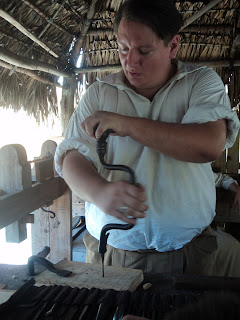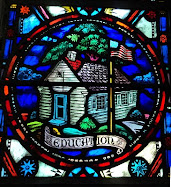 Just an hour ago, I finished reading the book Benjamin West and His Cat Grimalkin by Marguerite Henry to my kids as part of our unit study on colonial America. We love this book! Even my teenage son who read it in 4th grade snuck back into the living room to listen with his younger brothers and sisters. (Oh, his other assignments could wait. Fine with me!)
Just an hour ago, I finished reading the book Benjamin West and His Cat Grimalkin by Marguerite Henry to my kids as part of our unit study on colonial America. We love this book! Even my teenage son who read it in 4th grade snuck back into the living room to listen with his younger brothers and sisters. (Oh, his other assignments could wait. Fine with me!)The book is the a children's biography of the Father of American Painting, a young lad whose Quaker religious beliefs discouraged such a gaudy and useless diversion as creating pictures. But Benjamin was driven along by a strong inner desire to paint that won over his family and church. He even made paintbrushes from the fur of his loyal cat Grimalkin! His native friend Sassoonan showed him how to use clay and other natural ingredients to make paint, at least until kind Uncle Phineas sent him a paintbox and real brushes. His family and church came to realize that the beauty of art glorifies God. (This gives me goosebumps. I love art and I love God!)
Eventually Benjamin West became court painter for King George III in England as well as President of the Royal Academy of Arts. He trained such pupils as Gilbert Stuart, who is famous for his portrait of George Washington. I love the book because it is not dry and stuffy. It is a story of a real boy with real feelings and real adventures. It is recommended for ages 8-12. I love Marguerite Henry's other books for children, too, such as her horse classic Misty of Chincoteague.
We finished the book in three sittings, and in the closing pages, I read that his birthday was October 8, 1738. I was excited since that is today (and it's also my mother's birthday, so I thought she was born on his 200th) but on-line biographies say his birthday is October 10. That may be because they changed the calendar system in 1752 and adjusted lots of dates.
While I was on-line looking that factoid up, I located several of his paintings and showed them to my kids. He was especially famous for using period clothing in his historical works.
At the National Gallery of Art web site, you can find an index of some of his works and a biography. One of the paintings shown on the NGA site is "The Expulsion of Adam and Eve from Paradise." I also found his painting "Penn's Treaty with the Indians" at another site. Benjamin West's maternal grandfather was a personal friend of William Penn, the Quaker gentleman who founded the colony of Pennsylvania (Penn's forest) as a Holy Experiment with a goal of religious tolerance and fair treatment of native peoples.
Related to this, we just finished reading Hostage on the Nighthawk, a fictionalized account of William Penn that touches not only on his role as colony founder and governor, but also on his battle against the piracy which plagued his area. (My 11 year old son was drawing pictures of pirate ships as I read.) The book made the point that at first the Quaker pacifist Penn did not want to raise a militia to fight pirates, but he realized he couldn't turn a blind eye to wickedness and crime in the name of peace. Hostage on the Nighthawk is part of Dave & Neta Jackson's Trailblazers series aimed at the upper elementary and middle school age range. I checked to see if the book is available at Christian Book Distributors and notice that is it now bundled in a single volume with books about Martin Luther, John Paton, Hamilton Jones, and Marcus & Narcissa Whitman. You can find it here.
By reading Benjamin West and His Cat Grimalkin you can learn about art, American history, and Quaker beliefs all while enjoying well-written, heart-stirring literature. That's a mini unit study right there! At one point this morning, I stopped reading for a moment and told my kids, "This is why I'm home schooling you guys." And it is. Sharing great books and sharing life!
(If you click on the title link above, you can order it at CBD and even read an excerpt on-line. They also carry a picture book for slightly younger readers, The Boy Who Loved to Draw: Benjamin West by Barbara Brenner. I haven't read it yet, but we've enjoyed some of her other books from the library. Our Seminole County Library has this book, too, so I'll check it out tomorrow.)
Joy and beauty to you and yours,
Virginia Knowles
http://www.startwellhomeschool.blogspot.com/

































































